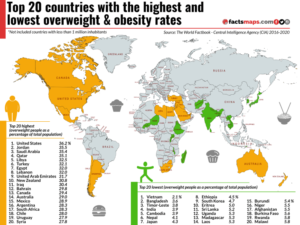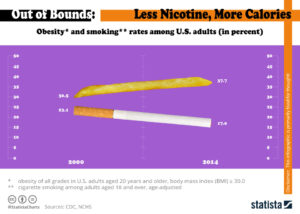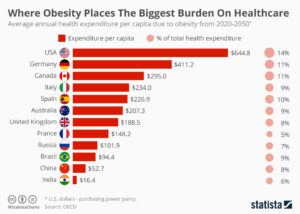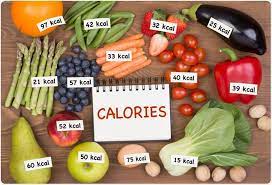Author- Mr Sudhir A Mahadik
Are you facing challenges regarding weight loss?
Do you think that losing weight is an impossible task?
If your answer is ‘Yes‘. Don’t worry……!
You are not the only person.
Being overweight is a global issue…..!

The epidemic of obesity is now recognized as one of the most important public health problems facing the world today. Adult obesity is more common globally than under-nutrition.
According to the World Health Organisation (2016), there are around 2 billion adults overweight, and of those 650 million are considered to be affected by obesity (BMI ≥30 kg/m²).
That equates to 39% (39% of men and 40% of women) of adults aged 18 or over who were overweight, with 13% obese. The worldwide prevalence of obesity nearly tripled between 1975 and 2016.
It is estimated that most of the world’s population lives in countries where overweight and obesity kill more people than underweight.
If current trends continue, it is estimated that 2.7 billion adults will be overweight, over 1 billion affected by obesity, and 177 million adults severely affected by obesity by 2025.
America is smoking less but getting fatter.

America is facing a sustained obesity crisis. Many doctors are warning that the fat scourge is reaching epidemic proportions. Some experts believe that obesity is responsible for more ill-health than smoking. Diabetes, heart disease, and high blood pressure are just three prominent illnesses that are caused by obesity.


What causes obesity?
In its simplest sense, the body gains fat when it stores excess energy, and this excess energy arises from consuming more food energy than is burnt in physiological metabolism.


What causes obesity?
In its simplest sense, the body gains fat when it stores excess energy, and this excess energy arises from consuming more food energy than is burnt in physiological metabolism.
This imbalance in energy consumption and expenditure has several causes: in some cases, it may be a genetic disorder but in most cases, it arises from living in an environment that allows and encourages low levels of physical activity, extended sedentary behaviour, and plentiful consumption of food, especially food rich in energy (e.g. in the form of fats, oils, sugars, and starches).
In such ‘obesogenic’ environments it is hard to resist weight gain as we are naturally programmed to minimize effort and store excess food as body fat. Once we have gained weight, however, it can be difficult to lose it.
Consequences of obesity-



Efforts to lose weight are frequently unsuccessful, and there is a continual feeling of hunger.




Why lose weight?
There are many reasons for losing weight:
Appearance: Some people may feel that if they lose weight, they will look more attractive, fitter, or healthier.
Confidence and body image: Some people with excess weight or obesity may feel uncomfortable about their appearance.
Overall health: Maintaining an appropriate weight can help to boost overall health and prevent diseases such as Type 2 Diabetes.
Specific conditions: Symptoms of sleep apnea or type 2 diabetes, for example, may improve or go away when a person loses excess weight.
Fitness: A weight-loss program that involves exercise can leave a person feeling fitter, with more energy and stamina.
Sports competitions: In some sports, such as boxing, an individual may seek to control their weight to stay in their existing weight category.
Fertility: Fertility treatment appears to be a more effective trusted source in women with obesity and polycystic ovary syndrome (PCOS) if they lose some weight before treatment.
Diets-


-
Desired weight loss
-
The desired speed of weight loss
-
Age
-
Sex
-
Sedentary: 2,600
-
Moderately active: 2,800
-
Active: 3,000
-
Sedentary: 2,400
-
Moderately active: 2,600-2,800
-
Active: 3,000
-
Sedentary: 2,200-2,400
-
Moderately active: 2,400-2,600
-
Active: 2,800-3,000
-
Sedentary: 2,000-2200
-
Moderately active: 2,200-2,400
-
Active: 2,400-2,800
-
Sedentary: 1,800 to 2,000
-
Moderately active: 2,000 to 2,200
-
Active: 2,400
-
Sedentary: 1,800
-
moderately active: 2,000
-
Active: 2,200
-
Sedentary: 1,600
-
Moderately active: 1,800
-
Active: 2000 to 2,200
If a person wants to lose weight, they should consume fewer calories than the amounts listed above. It is important to follow a healthy, well-balanced diet.
A person should check with a dietitian, nutritionist, or doctor, if possible, before changing their diet.
A person should make sure their carbohydrates, protein, and fat ratios are suitable for good health.
A meal plan should be balanced in terms of nutrients, as a poor diet and malnutrition occur regardless of calories. A poor diet can also lead to a low mood and loss of nutrition.
When a person has reached their target body weight, they should gradually increase their daily intake of calories until they reach their “weight maintenance” figure.

Follow these proven strategies to reduce your weight and boost your health.
Hundreds of fad diets, weight-loss programs and outright scams promise quick and easy weight loss. However, the foundation of successful weight loss remains a healthy, calorie-controlled diet combined with increased physical activity.
For successful, long-term weight loss, you must make permanent changes in your lifestyle and health habits.
How do you make those permanent changes? Consider following these six strategies for weight-loss success.

Long-term weight loss takes time and effort — and a long-term commitment. While you don’t want to put off weight loss indefinitely, you should make sure you’re ready to make permanent changes to your eating and activity habits. Ask yourself the following questions to help you determine your readiness:
- Am I motivated to lose weight?
- Am I too distracted by other pressures?
- Do I use food as a means to cope with stress?
- Am I ready to learn or use other strategies to cope with stress?
- Do I need other support — either from friends or professionals — to manage stress?
- Am I willing to change my eating habits?
- Am I willing to change activity habits?
- Do I have the time to spend making these changes?
Talk to your doctor if you need help addressing stressors or emotions that seem like obstacles to your readiness. When you’re ready, you’ll find it easier to set goals, stay committed and change habits.

- Find your inner motivation
No one else can make you lose weight. You must undertake diet and exercise changes to please yourself. What’s going to give you the burning drive to stick to your weight-loss plan?
Make a list of what’s important to you to help you stay motivated and focused, whether it’s an upcoming vacation or better overall health. Then find a way to make sure that you can call on your motivational factors during moments of temptation. You might want to post an encouraging note to yourself on the pantry door or refrigerator, for instance.
While you have to take responsibility for your behaviour for successful weight loss, it helps to have support — of the right kind. Pick people to support you who will encourage you in positive ways, without shame, embarrassment or sabotage.
Ideally, find people who will listen to your concerns and feelings, spend time exercising with you or creating healthy menus, and share the priority you’ve placed on developing a healthier lifestyle. Your support group can also offer accountability, which can be a strong motivation for sticking to your weight-loss goals.
If you prefer to keep your weight-loss plans private, be accountable to yourself by having regular weigh-ins, recording your diet and exercise progress in a journal, or tracking your progress using digital tools.

3. Set a Realistic Goal
It may seem obvious to set realistic weight-loss goals. But do you know what’s realistic? Over the long term, it’s smart to aim for losing 1 to 2 pounds (0.5 to 1 kilogram) a week. Generally, to lose 1 to 2 pounds a week, you need to burn 500 to 1,000 calories more than you consume each day, through a lower calorie diet and regular physical activity.
Depending on your weight, 5% of your current weight may be a realistic goal, at least for an initial goal. If you weigh 180 pounds (82 kilograms), that’s 9 pounds (4 kilograms). Even this level of weight loss can help lower your risk of chronic health problems, such as heart disease and type 2 diabetes.
When you’re setting goals, think about both process and outcome goals. “Walk every day for 30 minutes” is an example of a process goal. “Lose 10 pounds” is an example of an outcome goal. You don’t have to have an outcome goal, but you should set process goals because changing your habits is a key to weight loss.

4. Enjoy healthier foods
Adopting a new eating style that promotes weight loss must include lowering your total calorie intake. But decreasing calories need not mean giving up taste, satisfaction or even ease of meal preparation.
One way you can lower your calorie intake is by eating more plant-based foods — fruits, vegetables and whole grains. Strive for variety to help you achieve your goals without giving up taste or nutrition.
Get your weight loss started with these tips:
- Eat at least four servings of vegetables and three servings of fruits daily.
- Replace refined grains with whole grains.
- Use modest amounts of healthy fats, such as olive oil, vegetable oils, avocados, nuts, nut butter and nut oils.
- Cut back on sugar as much as possible, except for the natural sugar in fruit.
- Choose low-fat dairy products and lean meat and poultry in limited amounts.

5. Get active, stay active
While you can lose weight without exercise, regular physical activity plus calorie restriction can help give you the weight-loss edge. Exercise can help burn off the excess calories you can’t cut through diet alone.
Exercise also offers numerous health benefits, including boosting your mood, strengthening your cardiovascular system and reducing your blood pressure. Exercise can also help in maintaining weight loss. Studies show that people who maintain their weight loss over the long term get regular physical activity.
How many calories you burn depends on the frequency, duration and intensity of your activities. One of the best ways to lose body fat is through steady aerobic exercise — such as brisk walking — for at least 30 minutes most days of the week. Some people may require more physical activity than this to lose weight and maintain that weight loss.
Any extra movement helps burn calories. Think about ways you can increase your physical activity throughout the day if you can’t fit in formal exercise on a given day. For example, make several trips up and down stairs instead of using the elevator, or park at the far end of the lot when shopping.

It’s not enough to eat healthy foods and exercise for only a few weeks or even months if you want long-term, successful weight management. These habits must become a way of life. Lifestyle changes start with taking an honest look at your eating patterns and daily routine.
After assessing your personal challenges to weight loss, try working out a strategy to gradually change habits and attitudes that have sabotaged your past efforts. Then move beyond simply recognizing your challenges — plan for how you’ll deal with them if you’re going to succeed in losing weight once and for all.
You likely will have an occasional setback. But instead of giving up entirely after a setback, simply start fresh the next day. Remember that you’re planning to change your life. It won’t happen all at once. Stick to your healthy lifestyle and the results will be worth it.
Conclusion-
Generally, obesity can be cured. The majority of people don’t recognise How harmful it is to the body and their overall wellbeing. To be healthy and good in physical shape, a healthy diet along with moderate exercise is the solution to not becoming obese.